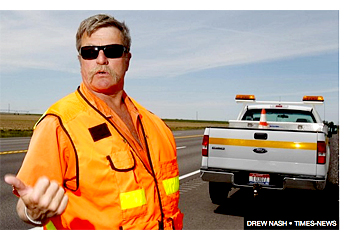
D-4's Dana helps remove impact of highway crashes
Steve Kadel
The Times News
TWIN FALLS - It’s not that Dave Dana minds getting his hands dirty, but one part of his job is a bit distasteful.
It’s roadkill, and the Idaho Transportation Department’s Twin Falls maintenance foreman occasionally has to wade right in.
“It’s an unsavory part of the job,” he said. “Just because I’m foreman doesn’t mean I don’t do my share.”
Animals accidentally killed by motorists on state highways range from raccoons, porcupines and coyotes to deer and elk. It’s never pleasant to remove them, although summer heat adds another element to the task.
“This time of year they swell up and they smell,” Dana said. “We try to get them as soon as possible before they go bad.”
 One of his workers regularly throws up while taking a carcass off the highway. It’s not so much the smell as the sight that bothers him, according to Dana.
One of his workers regularly throws up while taking a carcass off the highway. It’s not so much the smell as the sight that bothers him, according to Dana.
The foreman has his own remedy for odors — a liberal dose of Vicks VapoRub in both nostrils. And when it comes to skunks, the trick is to move quickly and accurately.
“You want to make sure you’re upwind and that your first pass is a good one that gets him off the road,” Dana said.
Dana’s a dog lover who finds it particularly difficult to retrieve canines and cats. He knows they’re probably someone’s pet.
“It’s sad,” he said, “but we have to get them off the road.”
He recalled the time he buried a dog, only to learn the pet’s owners wanted the body for their own burial ceremony. Dana had to dig up the dog and give it to them.
A shovel is the implement of choice to recover small animals. For larger ones, such as elk, the Twin Falls maintenance office has a truck with a winch. Deer are moved into the brush with some dirt thrown on top if the death occurs in the country. Deer that die in town are taken to a solid waste transfer site.
Rural highway districts and the Idaho Department of Fish and Game also are in the roadkill business, with staff members assigned to clean up when needed. Fish and Game’s website has a form the public can use to report roadkill, helping the agency and ITD prevent wildlife losses and danger to motorists.
Now, the public can even help with the cleanup. A new rule approved by the Idaho Legislature allows roadkill to be salvaged by citizens. Most species may be taken, except those listed as threatened or endangered.
North of the Snake River, most roadkill consists of deer and elk. Steve Cole, foreman for ITD’s Hailey district, said that’s because habitat in the Wood River Valley is so good for those species.
“We have a lot of elk,” he said, adding that an electronic message board warning motorists of the presence of wildlife has caused “a huge drop” in the number of animals killed.
The portable board has been used for two years, and is activated during times of the year when game crossings increase, Cole said.
Two years ago, before the warning sign went in, between 100 and 120 animals were killed by motorists up through the Wood River Valley to Galena Summit. Cole said only 30 animals have been killed this year.
Still, that area remains a prime spot for collisions with wildlife.
“It’s pretty much a year-round issue,” Cole said. “(Idaho Highway 75) goes right down the middle of that valley corridor. There are lots of animals crossing — it’s a popular place for animals and people.”
Published 6-1-2012